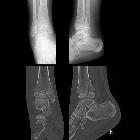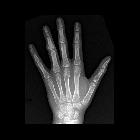Salter-Harris Klassifikation



Salter-Harrys
II (bzw. Aitken I) Fraktur des distalen Radius bei einem 12-jährigen. Man erkennt den Versatz von Meta- zu Epiphyse (Seitaufnahme) und die radiovolare Fraktur der Metaphyse.

Salter-Harris
classification • Salter-Harris type IV fracture - Ganzer Fall bei Radiopaedia

Salter-Harris
classification • Salter-Harris type II fracture - fifth finger - Ganzer Fall bei Radiopaedia

Triplane
fracture • Triplane fracture - Ganzer Fall bei Radiopaedia

Salter-Harris
classification • Salter-Harris illustrations - Ganzer Fall bei Radiopaedia

Salter-Harris
classification • Salter Harris type I shoulder injury - Ganzer Fall bei Radiopaedia

Salter-Harris
classification • Salter Harris type II wrist fracture - Ganzer Fall bei Radiopaedia

Salter-Harris
classification • Salter-Harris type I - fibula - Ganzer Fall bei Radiopaedia

Salter-Harris
classification • Salter-Harris type 1 fracture - finger - Ganzer Fall bei Radiopaedia

Salter-Harris
classification • Salter-Harris type III fracture of distal tibia with comminuted talus fracture - Ganzer Fall bei Radiopaedia

Salter-Harris
classification • Salter-Harris type I growth plate injury - Ganzer Fall bei Radiopaedia

Salter-Harris
classification • Salter-Harris type II wrist growth plate injury - Ganzer Fall bei Radiopaedia

Salter-Harris
classification • Salter-Harris fracture - Ganzer Fall bei Radiopaedia

Salter-Harris
classification • Ankle fracture - Salter-Harris type II - Ganzer Fall bei Radiopaedia

Salter-Harris
classification • Salter-Harris type IV fracture of distal tibia - Ganzer Fall bei Radiopaedia

Salter-Harris
classification • Salter Harris IV of the proximal phalanx - Ganzer Fall bei Radiopaedia

Salter-Harris
classification • Salter-Harris fracture of apophysis - Ganzer Fall bei Radiopaedia

Salter-Harris
classification • Salter Harris 4 fracture of index finger middle phalanx - Ganzer Fall bei Radiopaedia

The Salter-Harris classification was proposed by Salter and Harris in 1963 and at the time of writing (June 2016) remains the most widely used system for describing physeal fractures.
Classification
Conveniently the Salter-Harris types can be remembered by the mnemonic SALTR.
- type I
- slipped
- 5-7%
- fracture plane passes all the way through the growth plate, not involving bone
- cannot occur if the growth plate is fused
- good prognosis
- type II
- above
- ~75% (by far the most common)
- fracture passes across most of the growth plate and up through the metaphysis
- good prognosis
- type III
- lower
- 7-10%
- fracture plane passes some distance along with the growth plate and down through the epiphysis
- poorer prognosis as the proliferative and reserve zones are interrupted
- type IV
- through or transverse or together
- intra-articular
- 10%
- fracture plane passes directly through the metaphysis, growth plate and down through the epiphysis
- poor prognosis as the proliferative and reserve zones are interrupted
- type V
- ruined or rammed
- uncommon <1%
- crushing type injury does not displace the growth plate but damages it by direct compression
- worst prognosis
Others
There are a few other rare types which you should probably never include in a report as almost no one will know what you are talking about. Nonetheless, they are:
- type VI: injury to the perichondral structures
- type VII: isolated injury to the epiphyseal plate
- type VIII: isolated injury to the metaphysis, with a potential injury related to endochondral ossification
- type IX: injury to the periosteum that may interfere with membranous growth
Siehe auch:
- Aitken-Klassifikation
- Salter-Harris Typ 2 Fraktur
- SALTR
- Salter-Harris Typ 3 Fraktur
- Epiphysenlösung
- eingeschlagenes Periost
- Salter-Harris Typ 4 Fraktur
- Salter-Harris type I
- Twoplane-Fraktur
- Salter-Harris Typ 1 Fraktur
- Triplane-Fraktur
und weiter:
- Frakturen mit Eigennamen
- Tillauxfraktur
- paediatric curriculum
- Salter-Harris fracture classification (mnemonic)
- distale Tibiafraktur
- Kindliche Frakturen des OSG
- distal femoral epiphyseal injury
- Salter Harris type I fracture of the proximal tibial epiphysis
- Salter-Harris Type I Fracture of Tibia
- transphyseal fracture
- Thurstan-Holland-Fragment

 Assoziationen und Differentialdiagnosen zu Salter-Harris Klassifikation:
Assoziationen und Differentialdiagnosen zu Salter-Harris Klassifikation:








